Abstract
OBJECTIVE--To study the effect of intensive therapy of diabetes on the progression to clinical albuminuria in insulin dependent diabetic patients with microalbuminuria. DESIGN--Randomised controlled clinical trial of intensive versus conventional therapy of diabetes for a median of 5 years (range 2-8). SETTING--Nine hospital based specialist diabetes centres in England and Wales. SUBJECTS--70 European insulin dependent diabetic patients aged 17-59 years with microalbuminuria (albumin excretion 30-199 micrograms/min), but without arterial hypertension, recruited from the nine hospital based specialist diabetes centres. INTERVENTIONS--Intensive diabetic therapy was allocated to 36 patients (27 men, 9 women) and conventional diabetic therapy to 34 (24 men, 10 women). MAIN OUTCOME MEASURES--Development of clinical albuminuria, defined as albumin excretion greater than 200 micrograms/min on at least two consecutive occasions, and rate of change of albumin excretion. RESULTS--Mean glycated haemoglobin concentration, similar at baseline in the two groups (intensive therapy group 10.3% (SEM 1.9%), conventional therapy group 9.8% (1.6%)), fell significantly (by 14%) in the intensive therapy group only. A significant glycaemic separation between the two groups was maintained for up to three years. Progression to clinical albuminuria occurred in six patients in each group. Blood pressure, similar at baseline, fell significantly by 1 mm Hg (95% confidence interval -4.20 to 1.43) per year in the conventional therapy group, but the difference in the rate of blood pressure change between the groups was not significant. Independent of treatment assignment, a mean blood pressure above the group mean (93.6 mm Hg), but not the glycated haemoglobin concentration, predicted progression to clinical albuminuria (relative risk 4.2, 95% confidence interval 1.3 to 13.0). CONCLUSIONS--Intensive therapy with improved glycaemic control for three years had no impact on the progression of albuminuria in insulin dependent diabetic patients with microalbuminuria. The reduction in blood pressure in the conventional therapy group may have affected outcome--in that arterial blood pressure rather than glycated haemoglobin concentration seemed to be the main predictor of progression from microalbuminuria to clinical albuminuria.
Full text
PDF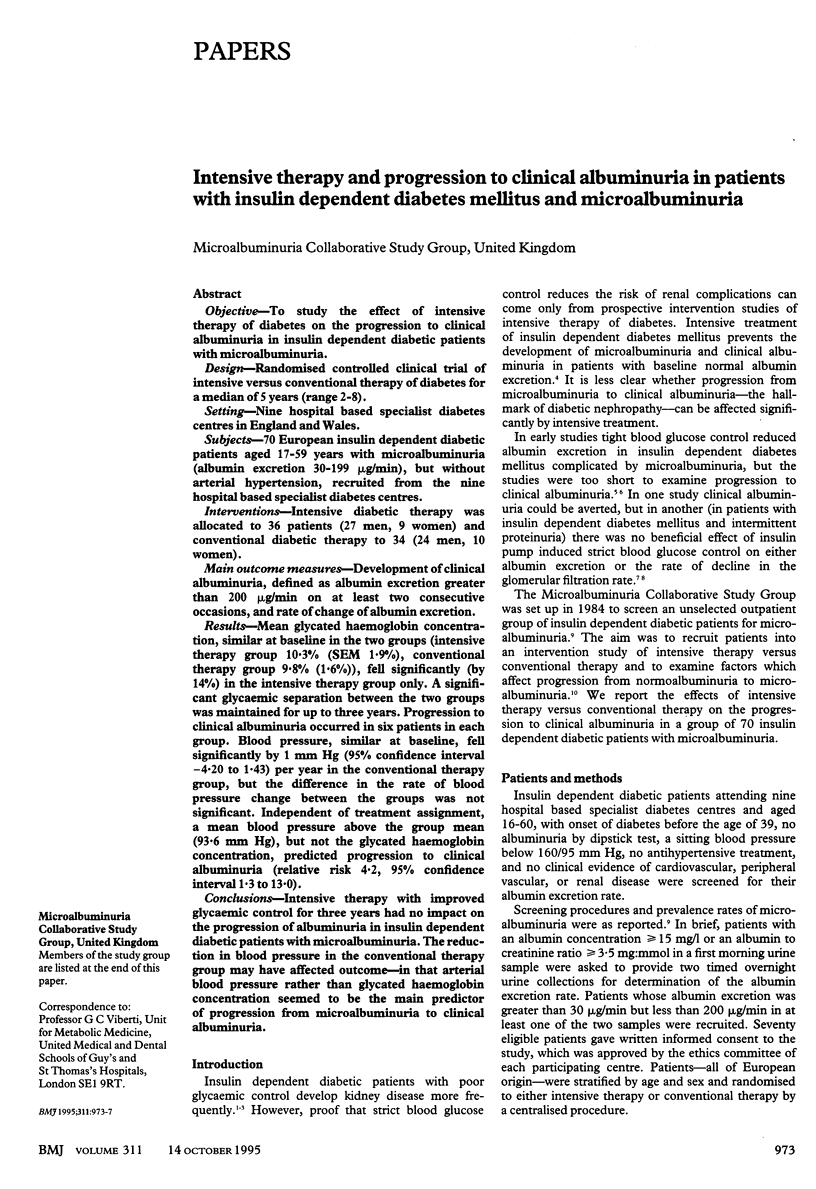
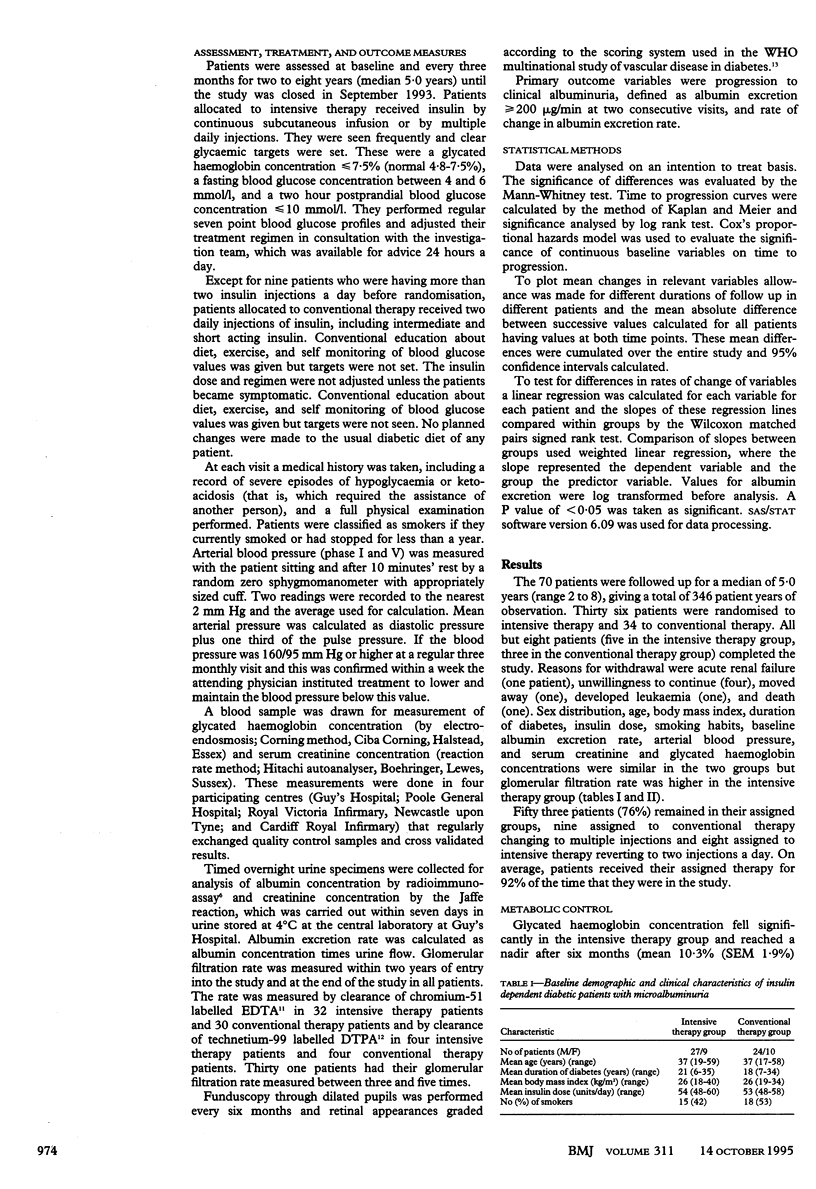
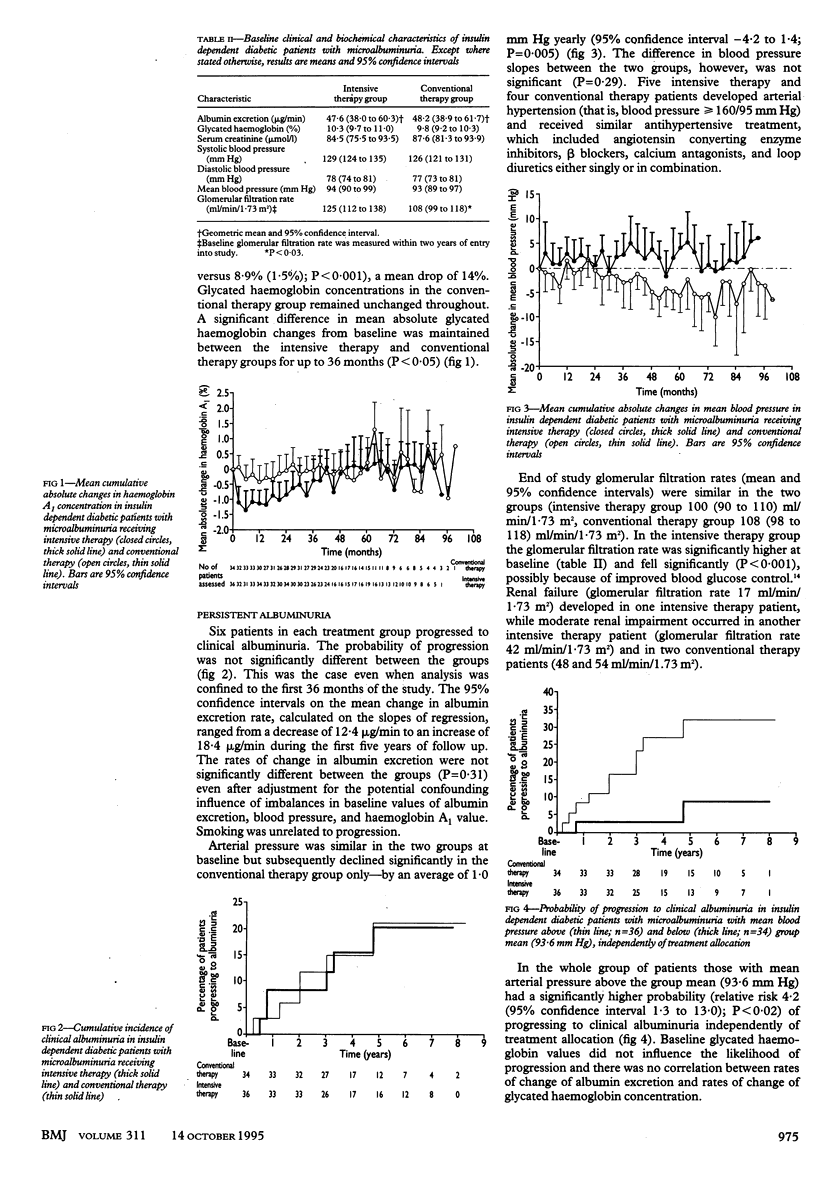
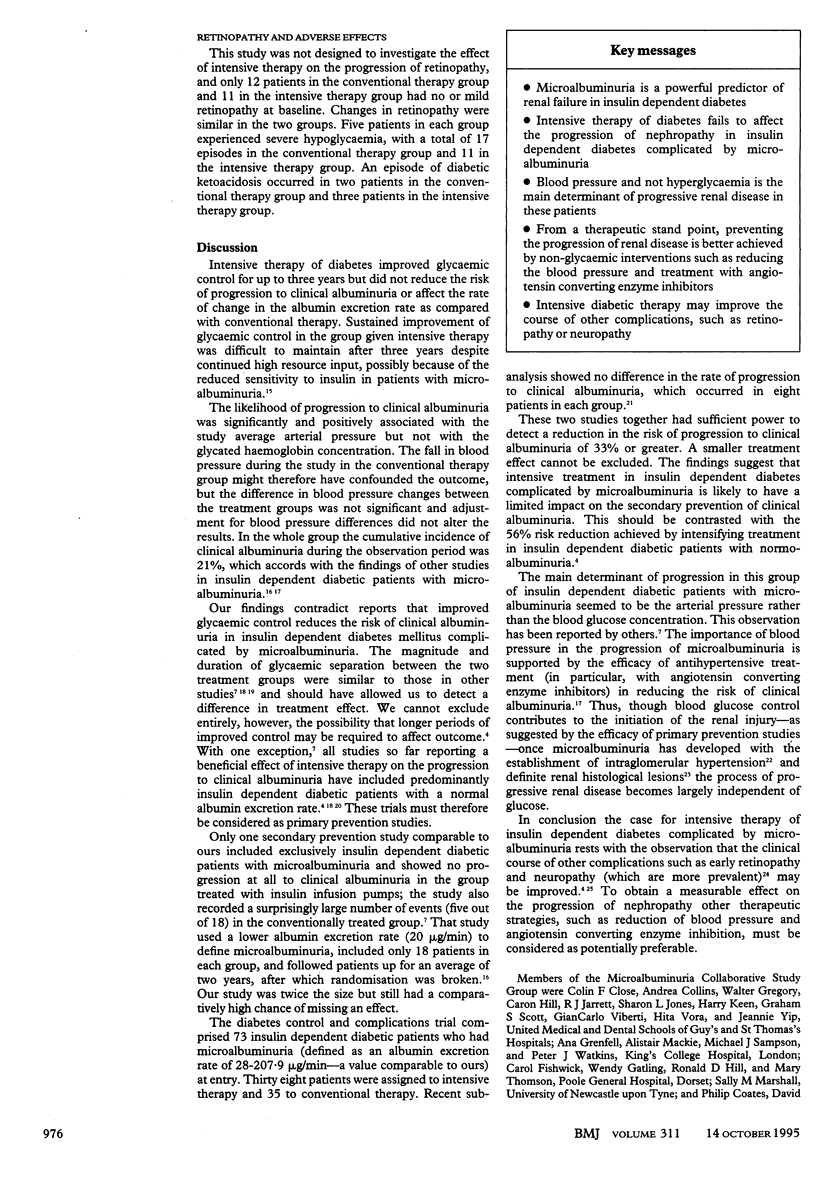
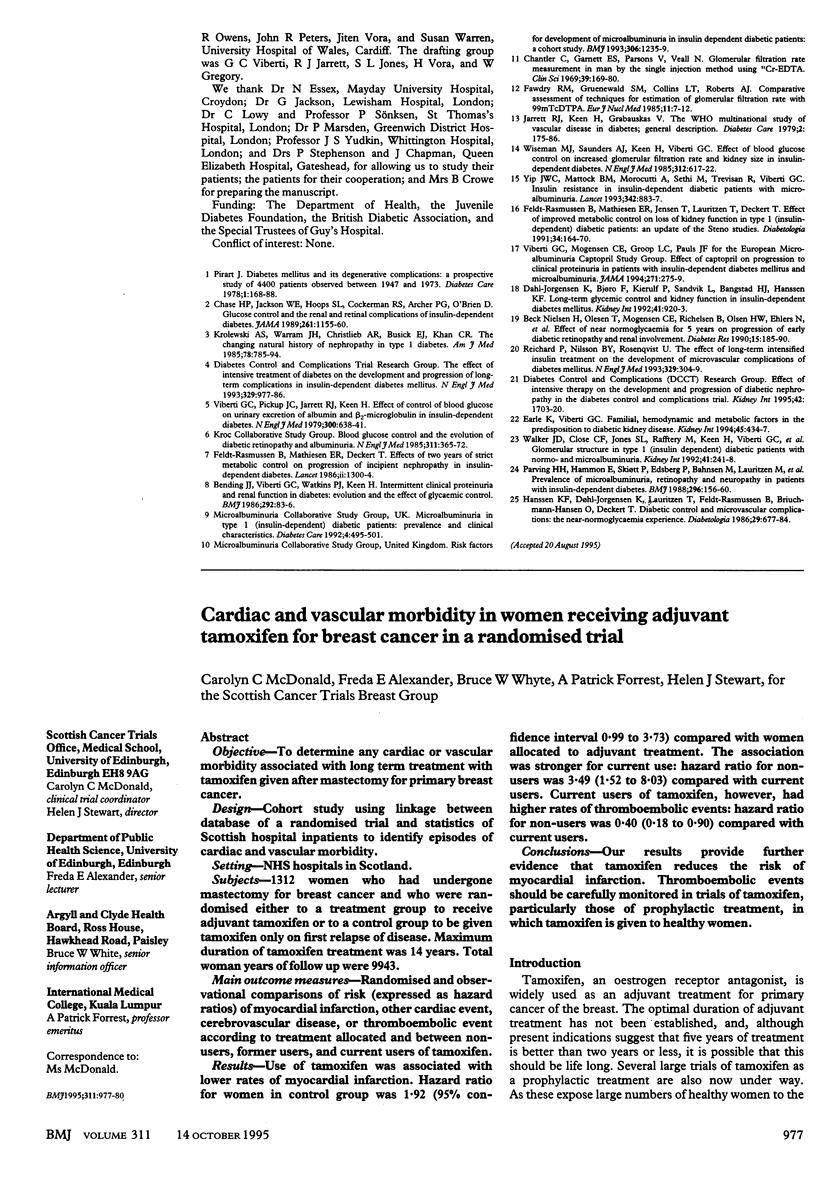
Selected References
These references are in PubMed. This may not be the complete list of references from this article.
- Beck-Nielsen H., Olesen T., Mogensen C. E., Richelsen B., Olsen H. W., Ehlers N., Charles P., Sørensen N. S. Effect of near normoglycemia for 5 years on progression of early diabetic retinopathy and renal involvement. Diabetes Res. 1990 Dec;15(4):185–190. [PubMed] [Google Scholar]
- Chantler C., Garnett E. S., Parsons V., Veall N. Glomerular filtration rate measurement in man by the single injection methods using 51Cr-EDTA. Clin Sci. 1969 Aug;37(1):169–180. [PubMed] [Google Scholar]
- Chase H. P., Jackson W. E., Hoops S. L., Cockerham R. S., Archer P. G., O'Brien D. Glucose control and the renal and retinal complications of insulin-dependent diabetes. JAMA. 1989 Feb 24;261(8):1155–1160. [PubMed] [Google Scholar]
- Dahl-Jørgensen K., Bjøro T., Kierulf P., Sandvik L., Bangstad H. J., Hanssen K. F. Long-term glycemic control and kidney function in insulin-dependent diabetes mellitus. Kidney Int. 1992 Apr;41(4):920–923. doi: 10.1038/ki.1992.140. [DOI] [PubMed] [Google Scholar]
- Earle K., Viberti G. C. Familial, hemodynamic and metabolic factors in the predisposition to diabetic kidney disease. Kidney Int. 1994 Feb;45(2):434–437. doi: 10.1038/ki.1994.56. [DOI] [PubMed] [Google Scholar]
- Fawdry R. M., Gruenewald S. M., Collins L. T., Roberts A. J. Comparative assessment of techniques for estimation of glomerular filtration rate with 99mTc-DTPA. Eur J Nucl Med. 1985;11(1):7–12. doi: 10.1007/BF00440953. [DOI] [PubMed] [Google Scholar]
- Feldt-Rasmussen B., Mathiesen E. R., Deckert T. Effect of two years of strict metabolic control on progression of incipient nephropathy in insulin-dependent diabetes. Lancet. 1986 Dec 6;2(8519):1300–1304. doi: 10.1016/s0140-6736(86)91433-9. [DOI] [PubMed] [Google Scholar]
- Feldt-Rasmussen B., Mathiesen E. R., Jensen T., Lauritzen T., Deckert T. Effect of improved metabolic control on loss of kidney function in type 1 (insulin-dependent) diabetic patients: an update of the Steno studies. Diabetologia. 1991 Mar;34(3):164–170. doi: 10.1007/BF00418270. [DOI] [PubMed] [Google Scholar]
- Hanssen K. F., Dahl-Jørgensen K., Lauritzen T., Feldt-Rasmussen B., Brinchmann-Hansen O., Deckert T. Diabetic control and microvascular complications: the near-normoglycaemic experience. Diabetologia. 1986 Oct;29(10):677–684. doi: 10.1007/BF00870275. [DOI] [PubMed] [Google Scholar]
- Jarrett R. J., Keen H., Grabauskas V. The WHO multinational study of vascular disease in diabetes: 1. General description. Diabetes Care. 1979 Mar-Apr;2(2):175–186. doi: 10.2337/diacare.2.2.175. [DOI] [PubMed] [Google Scholar]
- Krolewski A. S., Warram J. H., Christlieb A. R., Busick E. J., Kahn C. R. The changing natural history of nephropathy in type I diabetes. Am J Med. 1985 May;78(5):785–794. doi: 10.1016/0002-9343(85)90284-0. [DOI] [PubMed] [Google Scholar]
- Parving H. H., Hommel E., Mathiesen E., Skøtt P., Edsberg B., Bahnsen M., Lauritzen M., Hougaard P., Lauritzen E. Prevalence of microalbuminuria, arterial hypertension, retinopathy and neuropathy in patients with insulin dependent diabetes. Br Med J (Clin Res Ed) 1988 Jan 16;296(6616):156–160. doi: 10.1136/bmj.296.6616.156. [DOI] [PMC free article] [PubMed] [Google Scholar]
- Reichard P., Nilsson B. Y., Rosenqvist U. The effect of long-term intensified insulin treatment on the development of microvascular complications of diabetes mellitus. N Engl J Med. 1993 Jul 29;329(5):304–309. doi: 10.1056/NEJM199307293290502. [DOI] [PubMed] [Google Scholar]
- Viberti G., Mogensen C. E., Groop L. C., Pauls J. F. Effect of captopril on progression to clinical proteinuria in patients with insulin-dependent diabetes mellitus and microalbuminuria. European Microalbuminuria Captopril Study Group. JAMA. 1994 Jan 26;271(4):275–279. [PubMed] [Google Scholar]
- Wiseman M. J., Saunders A. J., Keen H., Viberti G. Effect of blood glucose control on increased glomerular filtration rate and kidney size in insulin-dependent diabetes. N Engl J Med. 1985 Mar 7;312(10):617–621. doi: 10.1056/NEJM198503073121004. [DOI] [PubMed] [Google Scholar]
- Yip J., Mattock M. B., Morocutti A., Sethi M., Trevisan R., Viberti G. Insulin resistance in insulin-dependent diabetic patients with microalbuminuria. Lancet. 1993 Oct 9;342(8876):883–887. doi: 10.1016/0140-6736(93)91943-g. [DOI] [PubMed] [Google Scholar]


